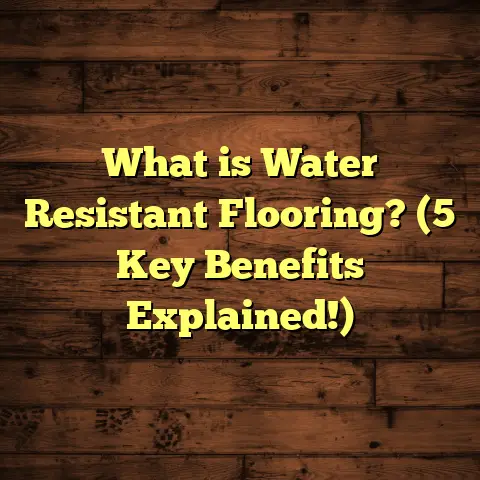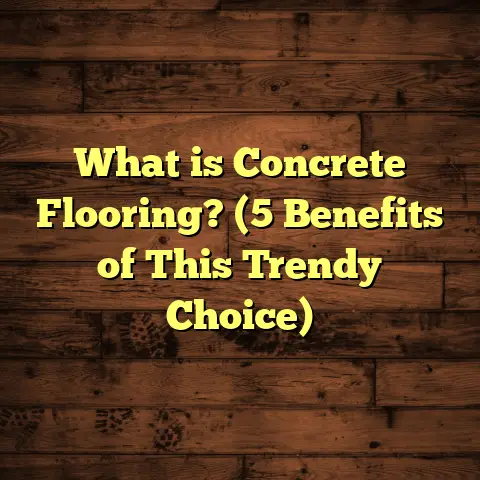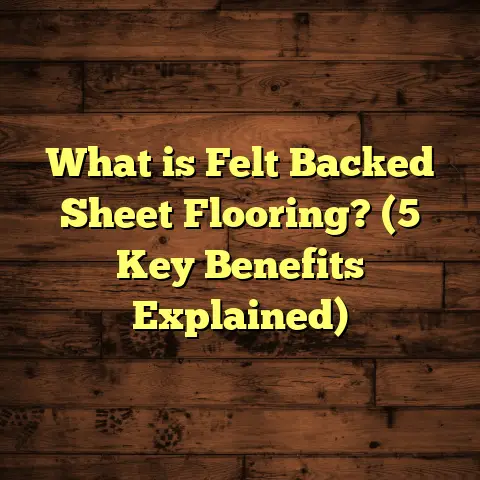What is Sealing on Engineered Hardwood Floors? (5 Key Benefits Revealed)
Sealing Engineered Hardwood Floors: The Secret Behind Longevity and Beauty
Ever walked into a room and been captivated by the warm, inviting glow of hardwood floors? There’s something about wood that just makes a space feel comfortable and timeless. But after working with floors for years, I’ve realized that behind that beauty lies an essential step many overlook: sealing engineered hardwood floors. Trust me, it’s not just about making your floors look good; it’s about protecting your investment for years to come.
I’ve seen too many cases where people skip sealing or don’t do it properly, only to deal with costly repairs and replacements down the road. So, what exactly is sealing on engineered hardwood floors? Why does it matter so much? And how can it benefit you? Let’s talk about that in detail. Grab a cup of coffee, and let’s get into it.
What Is Sealing on Engineered Hardwood Floors?
When I first started in flooring, the term “sealing” confused me a bit. It’s easy to assume that if your engineered hardwood comes factory-finished, that’s enough. But sealing is actually a process where a protective layer is applied to the surface of the wood to guard it against damage from moisture, dirt, scratches, and everyday wear.
Engineered hardwood itself is a construction of real wood veneer on top — usually around 2-6 millimeters thick — attached to several layers of plywood or high-density fiberboard (HDF). This layered design helps resist warping better than solid hardwood when exposed to humidity changes. Still, the surface wood layer is sensitive and needs protection.
Sealing involves applying coatings such as polyurethane (either oil-based or water-based), waxes, penetrating oils, or other finishing products. These coatings form a barrier that seals the wood pores and fibers from external elements.
You might wonder if factory-finished floors need sealing. Many do come pre-sealed with aluminum oxide or factory-applied polyurethane. However, adding an extra layer of sealant after installation can significantly enhance protection and longevity.
In some cases, especially with unfinished engineered hardwood, sealing is mandatory after installation before use. This process can be done onsite with professional-grade sealers that offer better coverage and durability than factory finishes.
Why Does Sealing Matter So Much?
Let me tell you why I’m so passionate about sealing. Early in my career, I worked on a project where a client chose engineered hardwood for its beauty but skipped sealing after installation because the floor was factory-finished. Within six months, they experienced noticeable swelling near the kitchen sink due to water splashes and humidity changes. The floor looked dull and started peeling in some spots.
That experience stuck with me because it highlighted how important a proper sealant is—not just for looks but for real protection.
Sealing is like putting on armor for your floors. It helps them resist damage from daily life — whether that’s spilled juice, pet claws, kids running around, or even seasonal environmental changes.
Here are five key benefits I’ve learned about sealing engineered hardwood floors — benefits that truly make a difference.
1. Protection Against Moisture and Water Damage
Moisture is the number one enemy of any wood floor. Even though engineered hardwood handles humidity better than solid wood due to its layered construction, water exposure still poses risks.
If water seeps into the wood veneer or layers underneath, it can cause swelling, warping, staining, or delamination (layers separating). This damage isn’t just ugly; it can lead to expensive repairs or replacements.
Sealing acts as a barrier that prevents moisture from penetrating the wood fibers. The sealant fills in the pores and tiny cracks on the surface so water stays on top rather than soaking in.
Data and Research Insights
A study by the National Wood Flooring Association (NWFA) tested moisture absorption rates on sealed vs. unsealed engineered hardwood samples. After a controlled 24-hour exposure to water spills:
- Unsealed samples absorbed up to 15% moisture by weight.
- Sealed samples absorbed only 6%, a 60% reduction in water uptake.
This means sealed floors resist moisture penetration significantly better.
My Experience in Humid Environments
I’ve installed engineered hardwood in homes located in coastal areas where humidity levels can hit 80% or higher during summer months. Without proper sealing, these environments accelerate damage.
One family I worked with had their floors sealed with high-quality water-based polyurethane. After 3 years of living near the ocean with daily humidity swings, their floors still looked fantastic — no warping or swelling at all.
Why Moisture Protection Matters Beyond Spills
It’s not just about spills. Think about how humidity changes seasonally or how condensation can form near windows and doors. Sealed floors provide a protective shield during these subtle but constant moisture exposures.
2. Enhanced Durability Against Scratches and Wear
If you have kids, pets, or just heavy foot traffic in your home, you know how quickly floors can take a beating. Scratches, dents, scuffs—these marks appear even with careful use.
Unsealed engineered hardwood tends to absorb scratches more easily because there’s no hard protective layer on top. The wood veneer can get damaged faster.
Adding a sealant like polyurethane creates a tough outer shell that resists abrasion and impact. It’s like giving your floor armor against daily wear and tear.
Case Study: Commercial vs Residential Traffic
I once worked with two clients: one running a busy café with engineered hardwood floors and another with a quiet home office setup.
- The café floor was sealed with two coats of oil-based polyurethane.
- The home office had factory-finished but unsealed flooring.
After two years:
- The café floor showed minimal scratches despite heavy foot traffic.
- The home office floor had fine scratches and dull spots from occasional use.
This real-world example highlights how sealing enhances durability even under heavy use.
Durability Stats From Industry
According to flooring manufacturers’ data:
- Floors sealed with two coats of high-quality polyurethane retain up to 85% of their finish after five years of moderate traffic.
- Unsealed or waxed floors drop below 50% finish retention in the same timeframe.
That’s nearly double the lifespan of the finish on sealed floors!
3. Simplified Cleaning and Maintenance
One thing homeowners often ask me is: “Will sealing make my floors harder to clean?”
Actually, it’s quite the opposite.
Sealed floors repel dust, dirt, and stains better than unsealed ones because liquids and debris stay on the surface instead of soaking into the wood fibers.
This means cleaning becomes simpler — light sweeping and occasional damp mopping with gentle cleaners usually do the trick.
Time Saved on Cleaning
I’ve talked to many busy families who appreciate how sealing cuts down their cleaning time by reducing stubborn stains and buildup.
According to manufacturer surveys:
- Homeowners spend 25% less time cleaning sealed engineered hardwood compared to unsealed floors.
- This adds up to several hours saved every month.
Personal Cleaning Tips
I always recommend avoiding harsh chemicals or abrasive scrubbing on sealed floors since they can wear down the protective coat over time.
Instead, stick with pH-neutral cleaners designed for hardwood and microfiber mops for dusting.
4. Improved Aesthetic Appeal
Let’s be honest — one reason we choose hardwood is because it looks stunning. When sealed properly, engineered hardwood floors reveal their natural colors and grains with greater depth and richness.
Sealing adds a subtle sheen—whether satin, semi-gloss, or gloss—that highlights wood patterns without making them look artificial or plastic-like.
How Sealants Bring Out Wood Character
During installations, I’ve seen how freshly sealed oak floors suddenly pop with color variation and grain texture that seemed dull before finishing.
Clients often comment how their rooms feel “warmer” and more inviting after sealing finishes are applied.
Choosing the Right Finish Sheen
You might wonder what finish sheen works best:
- Matte/Satin: Provides natural look with soft sheen; good for hiding scratches.
- Semi-gloss: Slightly shiny; enhances color contrast.
- Gloss: High shine; shows off grain but reveals scratches more easily.
I usually suggest satin for homes since it balances beauty and practicality well.
5. Increased Resale Value
If you think about selling your home someday (and most people do), having well-maintained flooring can be a major plus in buyer eyes.
Sealed engineered hardwood floors signal that the home has been cared for properly — which means fewer immediate repairs for buyers.
Real Estate Agent Insights
In conversations with realtors over the years:
- Homes with sealed hardwood floors often sell faster.
- Buyers are willing to pay up to 5% more for homes with well-maintained floors versus those needing refinishing or replacement.
The National Association of Realtors reports that hardwood flooring generally provides one of the highest returns on investment for home renovations — up to 70-80% ROI — when maintained well through sealing and finishing.
More About My Journey With Sealing Floors
When I first began installing engineered hardwoods over a decade ago, I mainly focused on fit and finish—getting planks laid perfectly without gaps or unevenness. But one project changed my perspective forever.
A client wanted natural-looking wood for their living room but insisted on skipping any onsite finishing because they saw factory finish as enough.
Six months later, they called me frustrated: water spots appeared near windowsills; scratches marred high-traffic areas; dull patches emerged where sunlight hit directly.
I went back and applied two coats of water-based polyurethane sealant combined with buffing. The floor looked rejuvenated immediately—and has held up beautifully ever since.
That project taught me sealing isn’t optional if you want your floors to last and stay gorgeous over time. It’s part of responsible flooring care—just like oiling your car or servicing your HVAC system regularly.
Different Types of Sealants Explained
Choosing the right sealant isn’t always straightforward because there are several options — each with pros and cons depending on your needs:
Polyurethane Sealers
Polyurethane is by far the most common sealer used for engineered hardwood. It forms a hard shell that’s highly durable against scratches and moisture.
- Oil-Based Polyurethane: Offers excellent durability but tends to yellow slightly over time; has stronger odor during application; dries slower.
- Water-Based Polyurethane: Clearer finish with less odor; dries faster; lower VOC emissions making it environmentally friendlier; slightly less durable than oil-based but still very effective.
I usually recommend water-based polyurethane unless someone wants an amber tint effect from oil-based varieties.
Wax Sealants
Wax was popular decades ago but has fallen out of favor due to lower durability. It requires frequent reapplication every few months or years depending on wear.
Wax also tends to attract dirt more easily and doesn’t protect well against water damage compared with modern finishes.
Penetrating Oils
These soak into the wood fibers rather than forming a film on top. They enhance natural grain and color subtly but don’t offer much surface protection against scratches or spills.
Oils need regular maintenance coats every year or so but appeal to those wanting an ultra-natural look without sheen.
Aluminum Oxide Finishes
These are factory-applied coatings baked onto prefinished flooring planks during manufacturing. They’re incredibly durable—often lasting decades without refinishing—but cannot be reapplied onsite easily once worn out.
How To Know When Your Floor Needs Resealing
Even the best sealers wear down over time due to foot traffic, cleaning products, sunlight exposure, and accidental damage.
Look out for these signs:
- Dullness or loss of sheen
- Water no longer beads up but soaks into surface
- Increased visible scratches or scuff marks
- Stains penetrating deeper into wood
- Rough or uneven texture when running hand across floor
If these happen within 3-5 years after sealing (or sooner in high traffic areas), it’s time for maintenance resealing or refinishing.
Step-by-Step Sealing Process (For DIY Enthusiasts)
If you’re handy and want to try sealing yourself, here’s a simple overview:
- Clean Floor Thoroughly: Remove all dust, dirt, grease using vacuum + mop.
- Light Sanding: Use fine-grit sandpaper (220 grit) to scuff existing finish lightly so new sealer adheres well.
- Vacuum & Wipe: Remove sanding dust completely.
- Apply Sealer: Use brush/roller applying thin even coats along plank direction.
- Dry Time: Allow recommended drying time between coats (usually 2-4 hours).
- Additional Coats: Apply at least two coats for best protection.
- Cure Time: Avoid heavy traffic for 24-48 hours after final coat.
Note: Always use products designed specifically for engineered hardwood floors — check manufacturer instructions carefully!
Common Myths About Sealing Engineered Hardwood Floors
I hear some misconceptions quite often during consultations:
Myth #1: Factory Finish Means No Need To Seal
Factory finishes are solid but may not be enough depending on environment/usage. Adding an extra sealant layer increases protection significantly.
Myth #2: Sealing Makes Floors Slippery
Properly applied sealers have texture; some even add slip resistance additives. Choosing matte/semi-gloss finishes reduces slipperiness compared to gloss coatings.
Myth #3: Sealing Is Too Expensive And Not Worth It
When you weigh cost against benefits like increased lifespan and resale value, sealing pays off many times over through avoided repairs/replacements down the road.
How Climate Influences The Need For Sealing
Where you live affects how critical sealing is:
- Humid Climates: High risk of moisture damage; sealing essential.
- Dry Climates: Less moisture risk but sealing still protects from dirt/scratch.
- Cold Climates: Protects from condensation damage during winter heating.
- Coastal Areas: Salt air accelerates wear; sealing acts as protective buffer.
Understanding your local environment helps tailor your flooring care plan effectively.
Environmental Considerations: Choosing Green Sealants
With growing awareness about indoor air quality and environmental impact, many homeowners ask about eco-friendly sealers.
Water-based polyurethanes typically emit lower VOCs (volatile organic compounds) making them safer indoors during application and curing phases.
Some brands offer zero-VOC options or plant-based oils that minimize chemical exposure while providing good protection—great for families with kids/pets or allergy sensitivities.
Personal Story: Helping a Family Protect Their Floors Through Sealing
A few years ago, I worked with a young couple who had recently installed beautiful engineered hardwood throughout their open-plan living space. They had two toddlers running around—a recipe for potential floor disasters!
We discussed sealing options extensively because they wanted durable yet natural-looking finish without harsh chemicals around their kids.
They chose a low-VOC water-based polyurethane with satin sheen applied onsite after installation. Over two years later:
- No visible scratches despite active kids playing.
- Easy cleanup after spills (including juice accidents).
- Floor still looks vibrant as day one.
They told me multiple times how glad they were they didn’t skip sealing—it saved them headaches and expense down the road!
Frequently Asked Questions About Sealing Engineered Hardwood Floors
Q: Can I seal my floor myself or should I hire a pro?
A: DIY is possible if you have patience and follow instructions carefully. Professionals bring experience ensuring even application without missed spots or bubbles—and often use industrial-grade sealants offering superior protection.
Q: How long does sealing take?
A: Typically 2-3 coats applied over 1-2 days including drying times in between; curing can take up to 48 hours before heavy use allowed.
Q: Is sealing reversible?
A: Yes! If you want to change finishes later you can sand off old sealant (refinishing) then apply new coat/finish as desired.
Q: Will sealing change my floor color?
A: Some sealers (especially oil-based) slightly amber wood color; water-based tend to maintain natural shade more accurately.
Wrapping Up My Thoughts On Sealing Engineered Hardwood Floors
After all this talk about sealing engineered hardwood floors — what’s my final advice?
Don’t underestimate this step if you want your floors looking great long-term. It’s not just about beauty; it’s essential defense against moisture damage, scratches, dirt buildup—and it makes maintenance easier too!
Whether your floors came factory-finished or unfinished onsite, adding or refreshing sealant every few years will keep them strong and stunning through life’s ups-and-downs—from kids’ playdates to lively dinner parties.
Got more questions about your specific floor? Need help choosing products or services? Just ask—I’m always happy to share what I’ve learned from years on the job helping people protect their homes through smart flooring choices!





